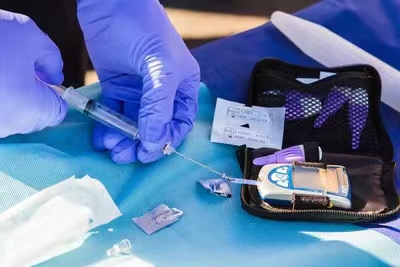创新背景
在英国,大约有40万人患有1型糖尿病,其中包括2.9万名儿童。由于这些患者不能产生胰岛素,葡萄糖会在血液中积聚,久而久之会对肾脏、心脏和眼睛造成严重损害。
1999年,沃克教授发现了控制“滤泡辅助T细胞”行为的信号,后来发现这些细胞在1型糖尿病患者中大量出现。1型糖尿病是一种自身免疫性疾病,这意味着它是由人体自身的免疫系统攻击健康的身体组织引起的。患有这种疾病的人无法产生胰岛素,而胰岛素是控制和利用葡萄糖作为能量所必需的。
创新过程
该研究小组由伦敦大学学院免疫与移植研究所(UCL Institute of Immunity & Transplantation)教授露西·沃克(Lucy Walker)领导,基于2014年的研究发现,某些被称为“滤泡辅助T细胞”(Tfh)的免疫细胞可以通过破坏胰腺中产生胰岛素的细胞来引发1型糖尿病。

在这项发表在《自然免疫学》杂志上的最新研究中,伦敦大学学院的研究人员与伦敦国王学院和阿斯利康公司的科学家合作,想要找出为什么一些1型糖尿病患者对Abatacept反应良好,而另一些人则不行。
Abatacept是一种免疫抑制药物,可抑制自身免疫性疾病患者的异常免疫反应,识别生物标志物将使临床医生能够将该药物用于那些有积极反应的患者。在解释这项研究的重点时,沃克教授说:“Abatacept已经被广泛用于治疗其他自身免疫性疾病,包括类风湿性关节炎。
“对1型糖尿病患者的早期测试发现,该药不适合常规使用,因为其反应变化很大——一些人受益良多,而另一些人则完全没有。能够提前知道谁可能有反应,可能会重新点燃对糖尿病患者的治疗兴趣。”
在这项研究中,研究了1型糖尿病患者的血液样本,这些人参加了Abatacept的临床试验。研究小组发现,通过Abatacept处理,Tfh细胞的数量减少,细胞的表型(生化特征)发生了变化。
然后,机器学习被用来比较对Abatacept反应良好的人和反应较差的人的血液样本。

让该团队惊讶的是,机器学习算法能够检测到Tfh细胞的差异,甚至在治疗之前,这可以用作生物标记,以确定某人是否可能对Abatacept有反应。
沃克教授说:“我们的新工作表明,通过分析这些T细胞,并观察它们表达的标记,我们可以预测人们对Abatacept的反应如何。下一步将在更多人身上进行测试,并探索它是否对其他疗法和其他自身免疫性疾病有效。Abatacept的新改进版本已经开发出来,生物标志物方法是否适用于这些药物将是特别令人兴奋的。”
创新价值
新的生物标志物可能会识别出那些将受益于免疫治疗药物Abatacept的1型糖尿病患者,这一发现最终可能会帮助数千人更有效地控制这种疾病。
创新关键点
机器学习算法能够检测到Tfh细胞的差异,甚至在治疗之前,这可以用作生物标记,以确定某人是否可能对Abatacept有反应。
创新主体
伦敦大学学院(University College London,简称:UCL ),1826年创立于英国伦敦,是一所公立研究型大学,为伦敦大学联盟的创校学院、罗素大学集团和欧洲研究型大学联盟创始成员,被誉为金三角名校和“G5超级精英大学”之一。
UCL是伦敦的第一所大学,以其多元的学科设置著称,于REF 2014 英国大学官方排名中,位列全英之冠,享有最多的科研经费。UCL的医学、解剖学和生理学、建筑学、教育学、考古学、计算机科学、计算金融学等学科排名均位居世界前列,与LSE并称为“英国现代经济学研究的双子星”;其人文学院颁发的奥威尔奖则是政治写作界的最高荣誉。
Innovative use of immunotherapeutic biomarkers to control type 1 diabetes
The research team, led by Lucy Walker, a professor at the UCL Institute of Immunity & Transplantation, based its findings in 2014 Certain immune cells called follicular helper T cells (Tfh) can trigger type 1 diabetes by destroying insulin-producing cells in the pancreas.
In the latest study, published in the journal Nature Immunology, researchers at University College London, working with scientists from King's College London and Astrazeneca, wanted to find out why some people with type 1 diabetes respond well to Abatacept while others do not.
Abatacept is an immunosuppressive drug that suppresses abnormal immune responses in patients with autoimmune diseases, and identifying biomarkers will allow clinicians to administer the drug to those patients who have a positive response. Explaining the focus of the study, Professor Walker said: "Abatacept is already widely used to treat other autoimmune diseases, including rheumatoid arthritis.
"Early tests in patients with type 1 diabetes found that the drug was not suitable for routine use because the response was so variable - some people benefited a lot and others not at all. Being able to know in advance who is likely to respond could reignite interest in treating people with diabetes."
In the study, blood samples were studied from people with type 1 diabetes who were enrolled in a clinical trial of Abatacept. The team found that with Abatacept treatment, the number of Tfh cells decreased and the phenotype (biochemical characteristics) of the cells changed.
Machine learning was then used to compare blood samples from people who responded well to Abatacept with those who responded poorly.
To the team's surprise, the machine learning algorithm was able to detect differences in Tfh cells even before treatment, which could be used as a biomarker to determine whether someone is likely to respond to Abatacept.
Professor Walker said: "Our new work shows that by analysing these T cells and looking at the markers they express, we can predict how well people will respond to Abatacept. The next step will be to test it on more people and explore whether it works with other therapies and other autoimmune diseases. New and improved versions of Abatacept have been developed and it will be particularly exciting to see if the biomarker approach is applicable to these drugs."
智能推荐
来自无标签 RNA 序列的新型基石模型预测RNA结构及功能
2022-07-20为了弥补标注数据的不足,本文展示了一项可为 RNA 各类研究提供丰富结构功能知识的基石模型 ——RNA foundation model (RNA-FM)。作为全球首个基于 23 million 的无标签 RNA 序列通过无监督方式训练得到的 RNA 基石模型,RNA-FM 挖掘出了 RNA 序列中蕴含的进化和结构模式。
涉及学科涉及领域研究方向生物识别新思路——凭借呼吸识别个人身份
2022-07-28研究团队分析了受试者的呼吸,从中筛选出28种可用于生物识别认证的化合物,并在此基础上开发了一个有16个通道的嗅觉传感器阵列。通过测试发现,依靠呼吸来识别出个人身份的平均准确率达到97.8%,证明了呼吸用于生物识别的可行性。
涉及学科涉及领域研究方向DNA分析揭示黑死病起源地
2022-07-02德国图宾根大学、马克斯·普朗克进化人类学研究所等机构的研究人员对7名14世纪的黑死病死者开展的 DNA 分析显示,黑死病可能源于欧亚大陆中部。
涉及学科涉及领域研究方向